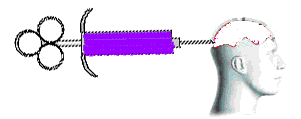Audience theory provides a starting point for many Media Studies tasks. Whether you are constructing a text or analysing one, you will need to consider the destination of that text and how that audience will respond to that text.
Over the course of the past century or so, media analysts have developed several effects models, such as theoretical explanations of how humans consume the information created by media texts and how this might influence a persons behaviour. Effects theory is still a debated area of Media, as no one is able to come up with indisputable evidence that audiences will always react to media texts one way or another.
The Hypodermic Needle Model

Dating from the 1920s, this theory was the first attempt to explain how mass audiences might react to mass media. It suggests that audiences passively receive the information created via a media text, without any attempt on their part to process or challenge the data.
The Hypodermic Needle Model suggests that the information from a text passes into the mass consciousness of the audience, for example the experience, intelligence and opinion of an individual are not relevant to the reception of the text. This theory suggests that, as an audience, we are manipulated by the creators of media texts, and that our behaviour and thinking might be easily changed by media-makers. It assumes that the audience are passive.
Two-Step Flow
As the mass media became an essential part of life in societies around the world. Paul Lazarsfeld, Bernard Berelson and Hazel Gaudet analysed the voters' decision-making processes during a 1940 presidential election campaign in the US and published their results in a book called "The People's Choice".
Their findings suggested that the information does not flow directly from the text into the minds of its audience unmediated but is filtered through "opinion leaders" who then communicate it to their less active associates, over whom they have influence. The audience then mediate the information received directly from the media with the ideas and thoughts expressed by the opinion leaders, this making them influenced but not by a direct process, but by a two step flow.
Uses & Gratifications
During the 1960s, as the first generation to grow up with television became grown ups, it became increasingly apparent to media theorists that audiences made choices about what they did when consuming texts. Far from being a passive mass, audiences were made up of individuals who actively consumed texts for different reasons and in different ways. In 1948 Lasswell suggested that media texts had the following functions for individuals and society; surveillance, correlation, entertainment & cultural transmission.
Researchers Blumler and Katz expanded this theory and published their own in 1974, stating that individuals might choose and use a text for the following purposes for example the Uses and Gratifications theory shows diversion,
personal relationships, personal identity, surveillance and a wider list as ways of consuming media texts.
Reception Theory
Extending the concept of an active audience still further, in the 1980s and 1990s a lot of work was done on the way individuals received and interpreted a text, and how their individual circumstances (gender, class, age, ethnicity) affected their reading.

This work was based on Stuart Hall's encoding/decoding model of the relationship between text and audience - the text is encoded by the producer, and decoded by the reader, and there may be major differences between two different readings of the same code. However, by using recognised codes and conventions, and by drawing upon audience expectations relating to aspects such as genre and use of stars, the producers can position the audience and thus create a certain amount of agreement on what the code means.













 Dating from the 1920s, this theory was the first attempt to explain how mass audiences might react to mass media. It suggests that audiences passively receive the information created via a media text, without any attempt on their part to process or challenge the data.
Dating from the 1920s, this theory was the first attempt to explain how mass audiences might react to mass media. It suggests that audiences passively receive the information created via a media text, without any attempt on their part to process or challenge the data.


